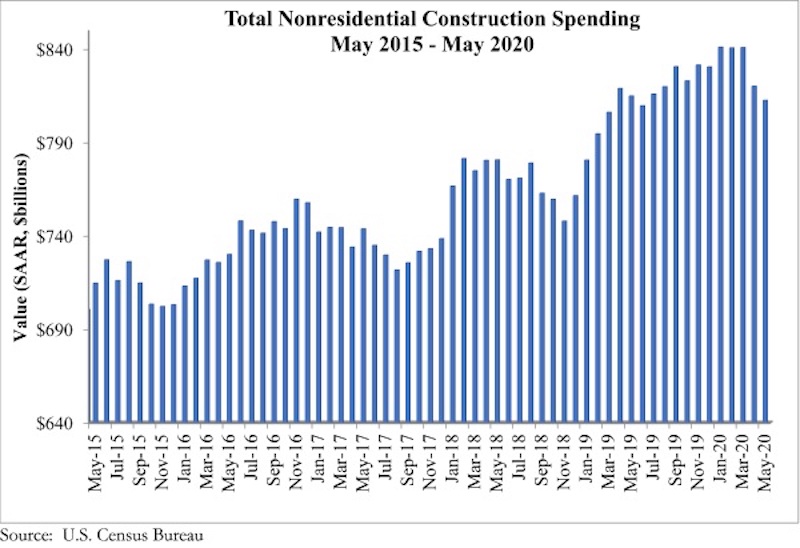National nonresidential construction spending declined 0.9% in May, according to an Associated Builders and Contractors analysis of data published today by the U.S. Census Bureau. On a seasonally adjusted annualized basis, spending totaled $812.5 billion for the month. Private nonresidential spending declined 2.4% in May and public nonresidential construction spending increased 1.2%.
“Certain aspects of today’s data release are precisely what was anticipated, while other elements are rather surprising,” said ABC Chief Economist Anirban Basu. “For instance, the precipitous 5.3% decline in health care-related construction spending is hardly shocking, as many elective surgeries, dental appointments and wellness checkups were postponed, resulting in billions of dollars of losses among medical systems. In addition, many medical systems have experienced large-scale layoffs in an effort to preserve cash balances.
“Other segments negatively affected include lodging, manufacturing and power, which was expected,” said Basu. “A general lack of travel and occupancy has slowed hotel construction. A shrunken global economy and disrupted worldwide supply chains have pummeled industrial construction. And the energy sector has taken a hit from commodity prices that remain significantly lower than pre-crisis levels, truncating demand for new construction.
“What is surprising is the overall stability of construction spending,” said Basu. “In May, nonresidential construction spending declined by less than 1%, which represents a level of stability not enjoyed by much of the balance of the economy. Spending in a number of categories, mostly public, was higher for the month, including highway/street, public safety, transportation and water supply. Moreover, certain construction segments may experience rapid recovery going forward, including health care, manufacturing and power. For now, construction spending data and ABC’s Construction Backlog Indicator, which stood at 7.9 months in May, show that the industry has managed to remain a bulwark of relative stability in the face of ongoing pandemic-induced economic dislocations.”
Related Stories
Market Data | Jan 18, 2017
Architecture Billings Index ends year on positive note
Architecture firms close 2016 with the strongest performance of the year.
Market Data | Jan 12, 2017
73% of construction firms plan to expand their payrolls in 2017
However, many firms remain worried about the availability of qualified workers.
Market Data | Jan 9, 2017
Trump market impact prompts surge in optimism for U.S. engineering firm leaders
The boost in firm leader optimism extends across almost the entire engineering marketplace.
Market Data | Jan 5, 2017
Nonresidential spending thrives in strong November spending report
Many construction firms have reported that they remain busy but have become concerned that work could dry up in certain markets in 2017 or 2018, says Anirban Basu, ABC Chief Economist.
Market Data | Dec 21, 2016
Architecture Billings Index up slightly in November
New design contracts also return to positive levels, signifying future growth in construction activity.
Market Data | Dec 21, 2016
Will housing adjust to an aging population?
New Joint Center report projects 66% increase in senior heads of households by 2035.
Market Data | Dec 13, 2016
ABC predicts modest growth for 2017 nonresidential construction sector; warns of vulnerability for contractor
“The U.S. economy continues to expand amid a weak global economy and, despite risks to the construction industry, nonresidential spending should expand 3.5 percent in 2017,” says ABC Chief Economist Anirban Basu.
Market Data | Dec 2, 2016
Nonresidential construction spending gains momentum
Nonresidential spending is now 2.6 percent higher than at the same time one year ago.
Market Data | Nov 30, 2016
Marcum Commercial Construction Index reports industry outlook has shifted; more change expected
Overall nonresidential construction spending in September totaled $690.5 billion, down a slight 0.7 percent from a year earlier.
Industry Research | Nov 30, 2016
Multifamily millennials: Here is what millennial renters want in 2017
It’s all about technology and convenience when it comes to the things millennial renters value most in a multifamily facility.



















